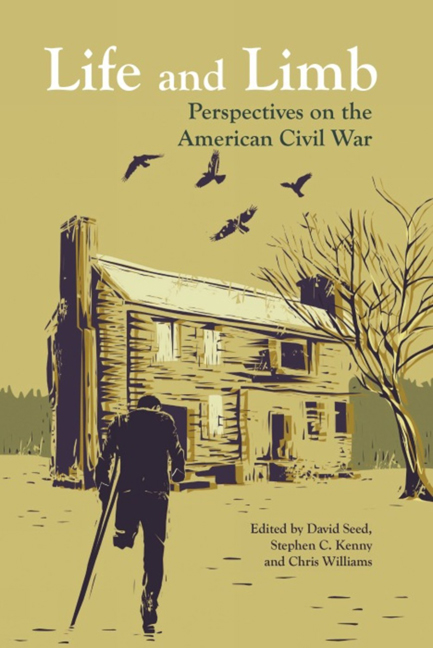Book contents
- Frontmatter
- Contents
- List of Illustrations
- Acknowledgements
- Introduction: Civil War Voices and Views
- MEDICAL AND SURGICAL MEMOIRS
- ACCOUNTS OF NURSING
- MEDICAL FACILITIES AND PATHOLOGY
- Jonathan Letterman on the Medical Corps: Medical Recollections of the Army of the Potomac
- The Confederate Military Prison Hospital at Andersonville, Georgia: Contributions Relating to the Causes and Prevention of Disease
- Field Hospitals: A Glimpse: Hardtack and Coffee
- Field Hospitals: The Need: A Manual of Military Surgery
- Plea for an Ambulance Service: A Brief Plea for an Ambulance System
- Hospital Broadside: North Carolina Hospital Broadside, 1863
- Hospitals in Richmond, Virginia: A Diary from Dixie
- Malingering: ‘Surgical Reminiscences of the Civil War’ and A Rebel's Recollections
- Roberts Bartholomew on Nostalgia: Contributions Relating to the Causes and Prevention of Disease
- Medical Welfare Begins: ‘Debut and Prospectus (The Crutch) and ‘Wounded’ (poem by ‘Sanatosia’)
- (Dis)embodied Identities: Civil War Soldiers, Surgeons, and the Medical Memories of Combat
- PHOTOGRAPHY
- AMPUTATIONS AND PROSTHETIC LIMBS
- IN THE FIELD OF BATTLE
- POST-WAR NARRATIVES
- Contributors
- Select Bibliography
- Index
- Plates
Field Hospitals: A Glimpse: Hardtack and Coffee
from MEDICAL FACILITIES AND PATHOLOGY
- Frontmatter
- Contents
- List of Illustrations
- Acknowledgements
- Introduction: Civil War Voices and Views
- MEDICAL AND SURGICAL MEMOIRS
- ACCOUNTS OF NURSING
- MEDICAL FACILITIES AND PATHOLOGY
- Jonathan Letterman on the Medical Corps: Medical Recollections of the Army of the Potomac
- The Confederate Military Prison Hospital at Andersonville, Georgia: Contributions Relating to the Causes and Prevention of Disease
- Field Hospitals: A Glimpse: Hardtack and Coffee
- Field Hospitals: The Need: A Manual of Military Surgery
- Plea for an Ambulance Service: A Brief Plea for an Ambulance System
- Hospital Broadside: North Carolina Hospital Broadside, 1863
- Hospitals in Richmond, Virginia: A Diary from Dixie
- Malingering: ‘Surgical Reminiscences of the Civil War’ and A Rebel's Recollections
- Roberts Bartholomew on Nostalgia: Contributions Relating to the Causes and Prevention of Disease
- Medical Welfare Begins: ‘Debut and Prospectus (The Crutch) and ‘Wounded’ (poem by ‘Sanatosia’)
- (Dis)embodied Identities: Civil War Soldiers, Surgeons, and the Medical Memories of Combat
- PHOTOGRAPHY
- AMPUTATIONS AND PROSTHETIC LIMBS
- IN THE FIELD OF BATTLE
- POST-WAR NARRATIVES
- Contributors
- Select Bibliography
- Index
- Plates
Summary
John B. Billings (1842–?) served in the 10th Massachusetts Battery of Light Artillery, and after the war published Hardtack and Coffee or, The Unwritten Story of Army Life (Boston, MA: George H. Smith, 1887). The memoir was illustrated by pen and ink drawings by Charles W. Reed, a topographical engineer on General Warren's staff.
I vividly remember my first look into one of these field hospitals. It was, I think, on the 27th of November, 1863, during the Mine Run Campaign, so-called. General French, then commanding the Third Corps, was fighting the battle of Locust Grove, and General Warren, with the Second Corps, had also been engaged with the enemy, and had driven him from the neighbourhood of Robertson's Tavern, in the vicinity of which the terrific Battle of the Wilderness began the following May. Near this tavern the field hospital of Warren's Second Division had been located, and into this I peered while my battery stood in park not far away, awaiting orders. The surgeon had just completed an operation. It was the amputation of an arm about five inches below the shoulder, the stump being now carefully dressed and bandaged. As soon as the patient recovered from the effects of the ether, the attendants raised him to a sitting posture on the operating-table. At that moment the thought of his wounded arm returned to him, and, turning his eyes towards it, they met only the projecting stub. The awful reality dawned upon him for the first time. An arm had gone forever, and he dropped backwards on the table in a swoon. Many a poor fellow like him brought to the operator's table came to consciousness only to miss an arm or a leg which perhaps he had begged in his last conscious moments to have spared. But the medical officers first mentioned decided all such cases, and the patient had only to submit. At Peach-Tree Creek, Col. Thomas Reynolds of the Western army was shot in the leg, and, while the surgeons were debating the propriety of amputating it, the colonel, who was of Irish birth, begged them to spare it, as it was very valuable, being an imported leg – a piece of wit which saved the gallant officer his leg, although he became so much of a cripple that he was compelled to leave the service.
- Type
- Chapter
- Information
- Life and LimbPerspectives on the American Civil War, pp. 62 - 63Publisher: Liverpool University PressPrint publication year: 2015



